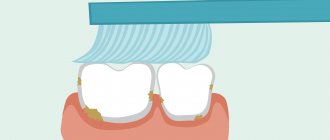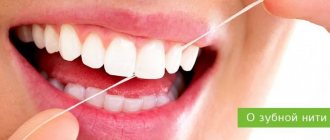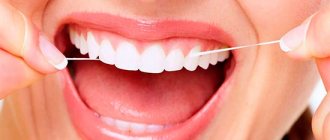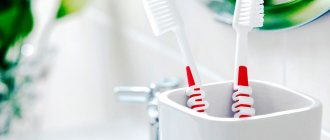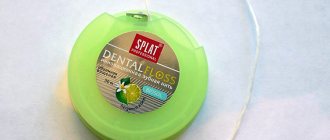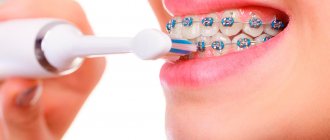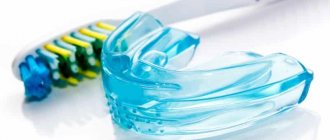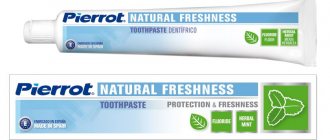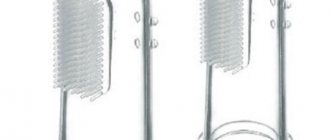During orthodontic treatment, patients experience difficulties with oral hygiene. This happens because the braces themselves and the arch that connects them prevent a regular toothbrush from cleaning plaque and food debris from the dental spaces. Moreover, the foreign complex structure itself becomes an additional source of infection, collecting the same food debris on the surface.
This problem can have serious consequences, since the dentist’s ability to prevent and treat caries while the patient is wearing braces is also significantly limited. Taking this fact into account, it is worthwhile to monitor oral hygiene as carefully as possible during the active phase of bite correction. You need to purchase everything for caring for braces from an online store or pharmacy. The dentist will definitely give you a list of necessary devices after installing the orthodontic structure.
Cleaning Basics
It is important to follow the instructions for use of the hygiene product in order to clean correctly with subsequent maximum effect.
Preparation
After eating, if you have braces, you should rinse your mouth and brush your teeth with a regular toothbrush. You can use a special toothbrush, however, it will not completely remove all food particles. Therefore, you should start working with dental floss, which has a second name - floss.
Cleaning instructions
Cleaning teeth with braces using floss is carried out in the following sequence:
- First, you should prepare the floss itself - only 20 cm will be enough to clean one tooth. The ends of the piece are wrapped around your thumbs, leaving a distance of 2-3 cm.
- It is recommended to start the procedure from the top row. To do this, a thread stretched with your fingers should be inserted under the metal arch of the braces, and then make zigzag movements towards the teeth - first moving up and then down. During movements, you should carefully touch the gums, but do not make sudden movements, as this can significantly damage the soft tissue.
- As soon as the interdental spaces are cleared , you should begin to remove plaque from the surface. To do this, floss is placed behind the tooth, and then it is wrapped around it to capture the back and side parts at once. Move up and down using the gums in the same way.
- After treating all the teeth , you need to start cleaning the bracket system itself. Its cleaning is carried out in the same sequence, only the floss introduced under the arc should be moved from one base to another. When cleaning, it is important to wipe the surface of the arc itself. After cleaning one segment, the thread is changed and moved on to the next.
- Once the top row of teeth is cleaned , you can move on to the bottom row. The index fingers are already used for pulling.
This is important: To achieve better cleansing, you need to change the pieces of floss each time. You cannot use one floss to clean several teeth, because after the first floss a huge amount of bacteria accumulates on it and is transferred from place to place. As a result, you can provoke destruction of the surface, which will be noticeable after the braces are removed.
Step-by-step instructions for using dental floss
Features in cleaning
The features and recommendations for brushing teeth with the designs presented by the hygiene product should be listed:
- It is better to carry out the procedure in front of a mirror;
- during preparation, it is recommended to use not a simple toothbrush, but a special orthodontic one with short bristles;
- when introducing floss under the arch, you should be careful, since if a snag occurs, the integrity of the system can be damaged;
- It is recommended to purchase a special puller for dental floss so as not to damage the structure;
- Do not press hard on the surface of the tooth while brushing, so as not to cause damage to the enamel;
- Parents should supervise their child's teeth brushing.
Often, after the first procedure, a person develops slight bleeding of the gums. In this case, there is no need to worry, it is enough to continue to be careful so that this does not happen again in the future.
Bleeding often develops due to sensitivity of the gums, which will also go away over time.
Recommendations
You can increase the effectiveness of this procedure if you follow certain recommendations:
- It is most convenient to cleanse in front of a mirror . This way you can track every movement and direction of the thread.
- Before using floss, it is recommended to clean with a special orthodontic brush .
Its bristles have a V-shaped cut, where the short central bristles efficiently process the surface of the braces, while the long outer bristles remove plaque from the enamel. - When pulling the floss under the arc, you should try not to touch its surface , as the fibers can catch on the structure and lead to its deformation or breakage.
- It should be borne in mind that the cleaning procedure with braces will be much longer than without them.
- To make it easier to position the floss under the orthodontic appliance, It is recommended to use a special device - a dental floss threader.
It is a small plastic structure that looks like a needle.During use, the tip of the floss is inserted into the eye of the threader, in the same way as a regular thread is inserted into a sewing needle. Then, the threader is pushed under the wire arch of the bracket system, while simultaneously pulling the floss under it.
After this, the thread is released from the auxiliary device and cleaned in a standard manner. The threader is used to clean each segment. This will speed up the procedure and more accurately position the floss.
- During the procedure, do not put too much pressure on the surface of the tooth when removing plaque, as this can damage the enamel.
- If, after the first application of floss, small drops of blood appear on the gums without painful manifestations, do not panic .
After a few days of daily use, gum bleeding will stop. If this does not happen, and the gums continue to bleed, you need to seek help from a dentist. - If a child wears braces, then cleaning should take place under the supervision of the parents . For young children, it is advisable for parents to thread the thread under the orthodontic structure themselves.
Which irrigator for braces should you choose for quality care?
Detailed description of dentin dysplasia.
Let's discuss the Mershona apparatus https://orto-info.ru/sistemyi-vyiravnivaniya-zubov/lechebno-profilakticheskie-apparatyi/mershona.html via the link.
Rules of procedure
It is necessary to study exactly the rules for flossing your teeth if you have braces in your mouth.
The following points stand out here:
- The remains of consumed food undergo decomposition , which occurs after a short time. This leads to damage to tooth enamel, so floss should be used after every meal.
- The presented hygiene product should be used even after a light snack. But if this is not possible, it is enough to use floss 3 times a day.
- When flossing, brush the front, back and sides of the tooth. We must not forget about the system itself, as well as about hard-to-reach places that are often not taken seriously by people - they are difficult to clean and cannot be seen.
- The movements are active, but not sharp - one wrong movement can significantly damage the enamel or gums. As a result, you may experience increased sensitivity or bleeding.
- Depending on which jaw is being processed - upper or lower - the thread is wound. If the upper jaw is being cleaned, it means that the end is placed under the arch from above and moved downwards. If the lower jaw is the opposite, floss from below and moves upward.
By following all the recommendations and features when brushing teeth with braces, you can maintain their health and beauty. In the absence of appropriate hygiene, after removing the braces, you have to deal with caries and other damage.
What toothpaste should you use to brush your teeth with braces?
Most often, braces care kits sold in stores include toothpastes with a high content of fluoride or calcium. This is justified by the fact that the orthodontic system has a negative effect on tooth enamel, slightly thinning it. However, dentists do not recommend frequent use of fluoridated toothpastes while wearing braces, as this may cause staining of the enamel. They will become especially noticeable after the system is removed and will require additional measures to restore the aesthetics of the smile.
From the point of view of doctors, the patient is recommended to concentrate his efforts on regular mechanical cleaning of teeth from plaque and food, without being carried away by the excessively abrasive and mineralizing effects of toothpastes.
Features of cleaning certain structures
Braces systems differ depending on the material of manufacture. Despite the fact that the purification technology itself is standard, there are certain clarifications in the procedure for distinctive materials.
Metal braces
Metal braces are used in most cases, so all cleaning features should be taken into account here. For the procedure, only waxed thread is used, which does not fray, which means it reduces the risk of snagging on the structure.
The introduction of floss under the system is also taken into account. The end must be inserted into the void between the teeth. This will be followed by cleansing - first they clean the side surface of one tooth, then move on to the adjacent one.
After these steps, you need to remove the piece of floss from the arch, replace it with a new one, and clean the next interdental space.
Ceramic braces
Porcelain is tooth-colored, so it is often used by those who are embarrassed to walk with metal in their mouth. These braces are quite fragile, but allow the use of waxed thread. Due to the fragility of the movement, it is important to carry out it calmly, without strong pressure.
Plastic braces
Plastic is more fragile than ceramics. Therefore, the use of floss must be extremely careful. It is important not to make sudden movements, and also not to press on the arches to avoid deformation.
Lingual braces
This type of braces system is installed behind the teeth, so they are not visible to others. Lingual braces are not very durable, so you should be as careful as possible when cleaning them.
To carry out a high-quality procedure, it is recommended to slowly clean by touch or use an additional mirror.
Main types of braces
Tips for cleaning braces with dental floss
All the features in cleaning the braces system have been listed above.
Now we should summarize the entire procedure:
- The appropriate floss should be used for the specific brace material.
- In addition to the surface of the teeth, it is also necessary to clean the structure itself.
- When cleaning the structure, it is important not to press too hard with the thread, so as not to provoke deformation.
- Additionally, you should use toothbrushes - they help remove large amounts of food stuck in the system.
- It is recommended to check the quality of the procedure using a mirror.
- At the end of cleaning, it is recommended to use a special antibacterial solution, which will help prevent the growth of bacteria in the absence of high-quality cleaning.
Following the recommendations will prevent the development of caries, which is manifested by unsightly dark spots in the place where the elements of the system were attached. It is difficult to get rid of them in the future, so it is better to immediately resort to effective preventive and hygienic methods.
What is dental floss?
Floss is a special thread made of silk or polymer fiber for high-quality cleaning of the spaces between incisors, canines, premolars, and molars. It helps remove food particles in a similar way to a toothpick, but is much safer and more effective. The fibrous structure of dental floss makes it possible to gently and gently remove deposits from the enamel, preventing bacteria from multiplying and destroying hard tissue. The floss is placed between the teeth, cleaning first one side and then the other side of the dentition. It is important to know how to use dental floss correctly, otherwise the opposite effect will be obtained instead of benefit.
Which one is needed?
It is not recommended to use non-waxed floss for brushing teeth, since in this case they can cause damage to the structure, despite the fact that such types are the best in the presented procedure.
Dentists talk about using a special thread - orthodontic, which significantly reduces the work for a person. If this is not possible, then choose the waxed variety.
Special dental floss for braces
Why is special thread recommended?
Orthodontic thread is called superfloss and consists of specially collected pieces.
These segments consist of the following elements:
- At the beginning of the segment there is a hard tip, which helps to easily insert the floss under the arch.
- Next comes the waxed thread.
- This is followed by the spongy part, which makes it possible to clean the entire surface of the tooth in 1-2 movements.
According to dentists, the best for braces is a special orthodontic thread. But its cost is high, so it is rarely used.
Using dental floss with a holder
Floss toothpick with holder –
Pharmacies sell many rather unhelpful oral care products on the shelves, which cost much more than high-quality dental floss, but at the same time cannot compare with them in effectiveness. An example of such a useless product is toothpick floss. Too short a length of dental floss, clamped in the holder, does not allow cleaning the interdental spaces as efficiently as can be done with a piece of regular dental floss 35-40 cm long, dragging it through the interdental spaces.
A floss toothpick with a holder allows you to make almost only vertical movements in the interdental space. This leads to the fact that food from the interdental space, on the contrary, can be pushed under the gum (this problem is especially typical in patients with periodontal pockets). In general, this is an ordinary marketing product, the demand for which is developed through advertising. But in any case, even a floss toothpick is better than if you don’t do interdental hygiene at all.
About the types
Dental floss is divided into two types, with the exception of superfloss. Here we distinguish between waxed and non-waxed.
The first type is covered with wax, which is why it does not have any “notches” that could damage the structure. Waxed ones are recommended for cleaning braces if there are a large number of fillings.
Based on the type of production, they are distinguished:
- round – excellent for cleaning interdental areas;
- flat – suitable for those who have many narrow areas in the oral cavity;
- tape - recommended for narrow gaps;
- voluminous - help clean the surface of the teeth due to their ability to swell upon contact with saliva.
Flat
Round
Tape
Volumetric
This is interesting: Manufacturers often impregnate threads with various aromatic solutions. This helps get rid of bad breath.
How to care for braces after installation?
A professional orthodontist must teach his patient how to properly clean the braces. Teeth under dirty metal structures can deteriorate very quickly, so it is necessary to pay attention to oral hygiene on a daily basis. Caring for braces after installation involves thoroughly removing plaque and (if possible) disinfecting metal elements. An electric toothbrush with special attachments will do the best job of cleaning orthodontic arches, rings and ligatures. Alternatively, you can purchase a regular brush with medium-hard artificial bristles.
First of all, you need to remove the removable rubber bands and thoroughly brush your teeth, then place the brush at an angle of 45 degrees to the jaw. The bristles should completely cover the ligature. You need to spend at least ten seconds on each tooth. In order to clean the braces from the inside of the jaw, you will need a special V-shaped single-tuft brush. After all the metal elements are perfectly clean, you need to take a special wax and lubricate all the places where the braces come into contact with the mucous membranes (including the interdental space). For greater convenience, you can use a special thin brush.
The Best Superfloss Brands
Since dentists recommend using superfloss, here are the best brands:
Oral b super floss
Oral b super floss (Oral b super floss) – is offered by Irish manufacturers in the form of segments in the amount of 50 pieces. Superfloss has a pleasant menthol smell and costs from 400 rubles.
Miradent
Miradent (miradent) - products from German manufacturers, helps not only clean teeth, but also, thanks to impregnation with chlorhexidine, destroy pathogenic bacteria. The cost of one package is from 600 rubles.
Mirafloss Implant CHX
Mirafloss Implant CHX (mirafloss implant) is the country of origin of the superfloss presented by the brand Germany. The thread is also impregnated with chlorhexidine, so it perfectly cleans and disinfects the oral cavity. The cost of one reel is from 500 rubles.
There are other brands of superfloss that are effective and expensive. Despite the prices, they are quite popular in Russia because they differ in quality.
How to choose?
The choice of floss depends on the structure of the dentition, so it is better to consult a doctor on this issue.
The main emphasis should be placed on the following factors:
- If you have an orthodontic system in your mouth, it is better to choose superfloss
If there are wide interdental spaces, dentists recommend using strip floss.
- Narrow spaces require the use of waxed threads to ensure easy glide.
- If you are planning to travel, give preference to disposable flossers or floss that has already been cut into pieces.
- If you have an orthodontic system in your mouth, it is better to choose superfloss.
This is important: It is also recommended to pay attention to the impregnation. If the gums are damaged, it is not recommended to use aromatic additives. Otherwise, you can only aggravate the problem. In this case, it is better to give preference to chlorhexidine impregnation.
What to do if the floss gets stuck
If dental floss gets stuck between teeth, you need to determine the cause. This happens if the size is incorrectly selected, if there are cracks, chips on the contact surface of the enamel or caries in this area. Another reason is tartar between the teeth, on which the floss clings, breaks, and as a result gets stuck.
To remove a stuck thread:
- rinse your mouth vigorously with water;
- rinse the interdental space with an irrigator;
- use a new thread to remove the problematic piece;
- use tweezers.
If these methods do not help, you should consult a doctor. Do not use needles, toothpicks, fishing lines, tines of forks or other sharp objects. This could result in serious injury. The dentist will remove the stuck piece quickly, without problems, using special tools.
Advantages and disadvantages of use
Cleaning your braces with dental floss has its advantages and disadvantages.
The positive aspects include ease of use - even beginners can successfully use the thread
The positive points include:
- The ability to clean hard-to-reach places that cannot be thoroughly treated with other hygiene products.
- Easy to use – even beginners can use the thread successfully.
- A large selection of flosses that are designed for a specific type of dentition and to treat existing problems.
But there are disadvantages, among which the main ones are:
- There is a high risk of gum injury, which can cause inflammation.
- Frequent use of floss provokes the destruction of interdental septa.
- Incorrect use leads to deformation of the structure, which necessitates the manufacture of a new one.
When choosing a thread and before cleaning your braces, carefully evaluate the pros and cons of the method.
Other tools
Other hygiene products are also offered for cleaning orthodontic structures, including:
- Brush – a micro brush allows you to clean the arches of braces. Its effect on the interdental space also has a positive effect.
- A single-tuft brush is a small tool with short, stiff bristles. Used to clean teeth and braces individually. Due to the high rigidity, there is a risk of damage to the enamel.
- Irrigator – the presented device allows you to clean your teeth and braces using only water pressure.
Irrigator
Single tuft brush
Ershik
Even highly effective hygiene products should be used regularly. If you don't have proper hygiene, you can end up in trouble.
Tools for caring for braces
Devices for caring for the oral cavity during orthodontic treatment may seem strange and uncomfortable at first glance, but they are not. If you are interested in where in Moscow you can buy an orthodontic toothbrush and brushes for cleaning braces, then just ask your dentist or search on the Internet. Today, most pharmacies and a large number of online stores offer a full range of hygiene products for patients undergoing orthodontic treatment. Moreover, the prices for these tools can vary, both from quite high for products of professional dental brands (for example, toothbrushes and brushes for Curaprox braces), and to absolutely affordable brushes from mass market brands (toothbrushes and brushes for Oral braces B (oral bi).
Cleaning bridge structures
Bridges are also popular in cases where the mouth suffers from a lack of teeth. To clean them, it is recommended to use superfloss type dental floss.
Other cleaning features of the presented structures include:
- The thread is pre-lubricated with toothpaste to facilitate sliding
Before using the hygiene product in question, it is recommended to clean the interdental space with a brush.
- The thread is pre-lubricated with toothpaste to facilitate sliding.
- Then thread the thread into the interdental space and wrap it around one tooth in the shape of the letter “P” - this way the entire hard-to-reach part will be cleaned.
- For the designs presented, it is recommended to use flat floss.
The dentist, who will be guided by the structure of the dentition, will tell you about other features of cleaning bridges.
Reviews
Maria Korshunova, 32 years old, Penza: “I decided to get braces because I wasn’t happy with my crooked teeth. I had to use dental floss. I was satisfied with the Miradent brand; they have a large selection of different aromatic scents.”
Anatoly Rabich, 46 years old, Moscow: “Due to age, I had to install bridges. Cleaning them turned out to be a real chore, but superfloss threads came to the rescue. This is a really good invention, because now my teeth brushing time has been halved.”

